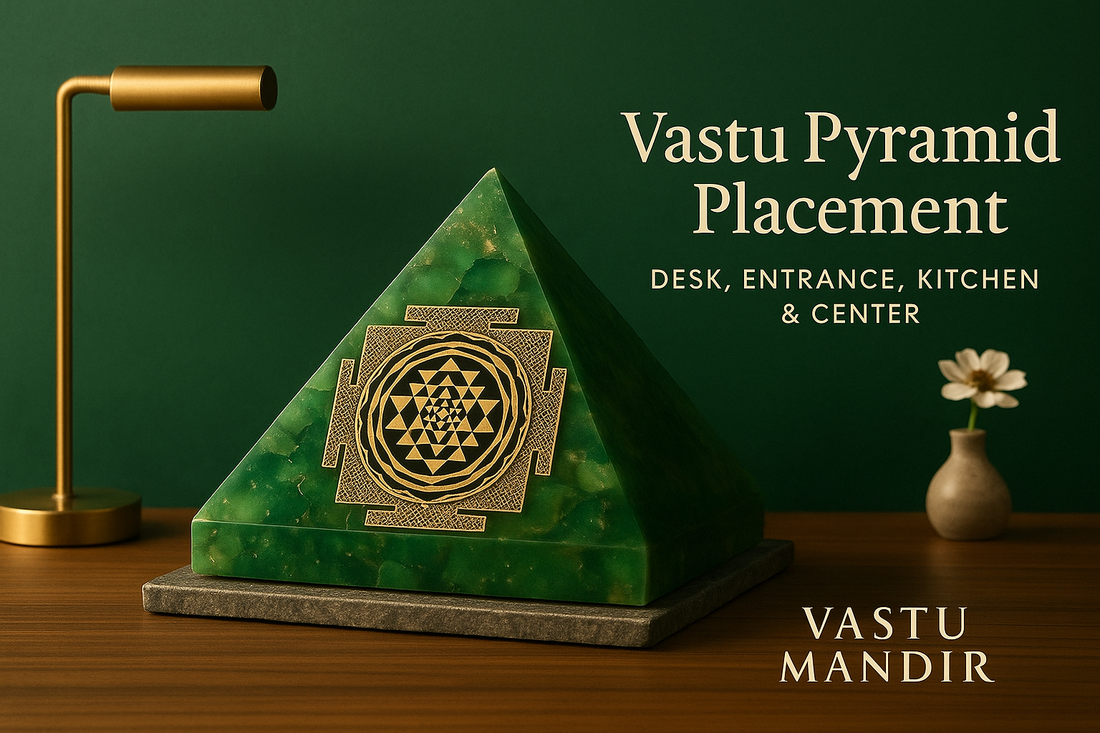
Vastu Pyramid Placement: Where to Keep, Types & Gentle Rules (Modern, Calm Guide)
Vastu MandirShare
1) What a Vastu pyramid does (in plain words)
Think of a pyramid as a small, steadying presence. It doesn’t ask for attention; it organises a corner. When you place it carefully—clear surface, aligned with the room, softly lit—it encourages order and an easier flow through the day. Many households use pyramids for gentle corrections where renovation isn’t possible—entrances that feel tired, kitchens that run hot, desks that feel scattered.
2) Where to keep a Vastu pyramid (home & work)
A) Near the entrance (clarity as you step in)
Place a pyramid on a stable ledge or console close to the main door, not blocking movement. Keep the area bright and uncluttered; the point faces up, base aligned square with the wall. This is a popular urban remedy when you can’t rebuild door orientation.
B) Northeast / East (focus & calm)
The NE (or East) corner is often chosen for clarity and light. Use materials that feel calm (metal, crystal, or fine wood). Keep the surface clean; avoid mirrors directly behind it.
C) Center of home — Brahmasthan (open, not crowded)
If your layout allows, the central zone (Brahmasthan) benefits from openness. A single pyramid on a low, uncluttered plinth is enough; let the space breathe. Don’t force this if the center is a thoroughfare.
D) Kitchen — balanced fire (subtle, not showy)
In kitchens that feel intense, place a metal/brass pyramid toward the southeast (the ‘fire’ side), on a clean, heat-safe surface—away from flames and water splashes. Keep it tidy and wipe regularly.
E) Work desk or study (directional flow)
Set a crystal or copper pyramid at the desk—preferably when you face east or north while working. Keep papers in order; the pyramid sits clear of monitors and cords.
Good rule of thumb: choose the one place that will stay uncluttered every day. Pyramids work best where you can keep the surface clear and the light consistent.
3) Which type: a quick, honest guide
-
Brass / Metal (3-layer, plate-style): Feels grounded and premium; suits entrances, kitchens, and living areas.
-
Copper: Clean, architectural look; often chosen for desks and focused corners. Align base edges neatly with the wall lines.
-
Crystal / Clear: Disappears into minimal interiors; good for shelves where visual lightness matters.
-
Wood / Resin: Warmer presence; ensure the finish isn’t glossy or kitsch.
(You stock multiple builds—including 3-layer brass, copper, and lead variants—so the language above lets readers choose by feel without pushing SKUs.)
4) How to place it well (the premium way)
-
Surface: Stable, level shelf or console; keep it at or near eye height in living zones; lower in the center of home.
-
Alignment: Square the base to the room’s lines; avoid crooked placement. (Some practitioners also align to cardinal directions; do this only if you can do it cleanly.)
-
Light: Neutral daylight or a soft 5000–6000K wash; avoid blue-tinted LEDs.
-
Backdrop: Wood, stone, or calm plaster; skip mirrors and busy graphics.
-
Company: One or two companions—a small diya (safe, on stone), a bowl with petals. Don’t crowd.
-
Care: Dust weekly; keep fingerprints off metals; if near a stove or sink, wipe more often.
5) Room-by-room ideas (simple, practical)
-
Foyer/Entrance: Pyramid on console; warm neutral light; remove visual noise (keys, random mail).
-
Living / Family area: Center the pyramid on a slim marble plinth; let it read as a single, quiet statement.
-
Kitchen (SE bias): A metal/brass pyramid placed away from splashes; keep cloth and paper at a safe distance.
-
Study / Office: Compact copper/crystal pyramid near the monitor corner, not blocking the screen; desk faces east or north when possible.
-
Bedroom: If used here, keep it visible on a dresser or shelf—not under the bed; keep lines simple and soft.
6) Gentle adjustments (no renovation)
-
If the entrance feels heavy, brighten the landing and place a pyramid on a clean ledge; keep surrounding objects to a minimum.
-
If the center is crowded, don’t force a display there; choose an east/NE ledge and balance with light instead.
-
If the kitchen runs hot, tidy the cook zone; place the metal pyramid on a clear, SE counter—far from direct flame. -
-
If the desk feels scattered, reorder cables and files; set a small copper/crystal pyramid at the corner you see most.
7) Common missteps to avoid
-
Mirrors directly behind the pyramid (visual noise, reflections).
-
Blue LEDs that make everything feel cold and hard.
-
Overcrowding—a pyramid buried under perfumes, trinkets, or piles of paper.
-
Unstable surfaces—wobbly trays, narrow ledges.
-
Grease and soot in kitchen corners; wipe gently and often.
8) What people ask (quick answers)
Is there a “perfect” number of pyramids?
Keep it simple—one in one place you’ll actually keep tidy feels more meaningful than sprinkling many. (Complex “number” rules vary by tradition; we prefer clarity over count.)
Which rooms respond best?
Entrances, living areas, SE kitchens, and work desks. Bedrooms only if the layout allows a clear, respectful spot.
Does orientation matter?
Clean alignment with the room’s lines is non-negotiable. Aligning the base to cardinal directions is optional—do it only if it looks composed and the placement remains practical.
9) Warm reminders (instead of a checklist)
-
Choose one clear location; keep it cared for.
-
Let light do half the work—neutral, gentle, consistent.
-
Align the base; avoid tilts and diagonal clutter.
-
Fewer companions; more breathing room.
-
Wipe, reset, repeat—small care, every week.







